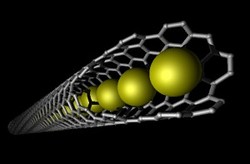Carbon nanotubes provide the perfect molds for growing metal nanowires as small as just one atom thick and protecting them from degradation

Fig. 1: Nanowires comprising a chain of single metal atoms can be grown inside a carbon nanotube.
c 2010 Shinohara Research Laboratory
In theory, the smallest possible metallic wire is a chain of single atoms. Beyond the obvious advantage of consuming smaller quantities of raw materials, such nanowires -- with diameters on the order of several nanometers -- should display novel electronic and magnetic properties because the movement of electrons is confined to one dimension.
However, the synthesis of single-atom nanowires is difficult because once made they are extremely sensitive, and remain stable only under high-vacuum conditions. This limitation has now been overcome in part by a team of researchers from the Institute for Advanced Research and Chemistry GCOE at Nagoya University and the National Institute of Advanced Industrial Science and Technology, which has found a way to synthesize metal nanowires more efficiently1.
Team leader Hisanori Shinohara, Ryo Kitaura and their co-workers tried heating the relatively volatile metal europium in a mixture with carbon nanotubes having internal diameters of 0.4-50 nm. They found that the tube became filled with metal atoms, thus creating a metal nanowire trapped within a carbon nanotube (Fig. 1).
"The resulting nanowires are stable under ambient conditions and even in solution," says Shinohara. "This allowed us to measure their structure using high-resolution electron microscopy techniques and observe their unique magnetic properties."
The structure of the nanowires thus formed depends on the diameter of the carbon nanotube. Nanowires with between one and four metal atom chains have been synthesized using the method. The carbon nanotube also acts like a 'mold', allowing very regular nanowires to be obtained.
Beyond simply investigating the structure and properties of these nanowires, there is much potential for this work. "The synthetic procedure should be applicable to any volatile metal, and we hope to prepare nanowires from non-magnetic metals as these may show superconducting properties at low temperature," says Shinohara. And because the nanowires are stable within the carbon nanotubes, it isn't hard to imagine them being used to connect components in high-performance nanocircuits.
There is still much to research in this area. "Using this method, we have already been able to prepare nanowires from mixtures of metals. This allows us to tune their electronic and magnetic properties," says Shinohara.
Carbon nanotubes with similar diameters can also have slightly different structures, or chiralities, and this can change the properties of the carbon nanotubes themselves from being metallic (conducting) to semiconducting. "We are investigating the growth of nanowires inside both metallic and semiconducting nanotubes," says Shinohara. "It seems as though the precise structure of the nanowire is dependent on the chirality of the nanotube."
Affiliated Researchers
The Nagoya University affiliated authors mentioned in this highlight are from the Institute for Advanced Research and the GCOE for the Elucidation and Design of Materials and Molecular Functions
Reference
- Kitaura, R., Nakanishi, R., Saito, T. Yoshikawa, H., Awaga, K. & Shinohara, H. High-yield synthesis of ultrathin metal nanowires in carbon nanotubes. Angew. Chem. Int. Ed. 48, 8298-8302 (2009). | article